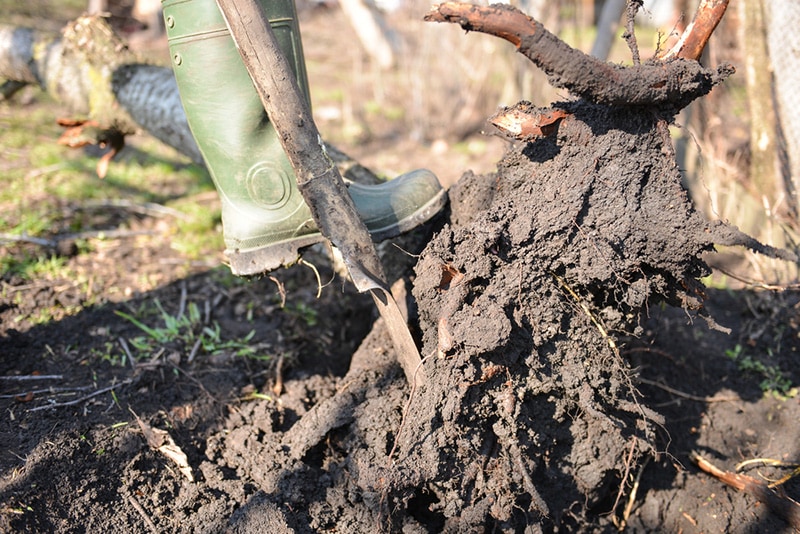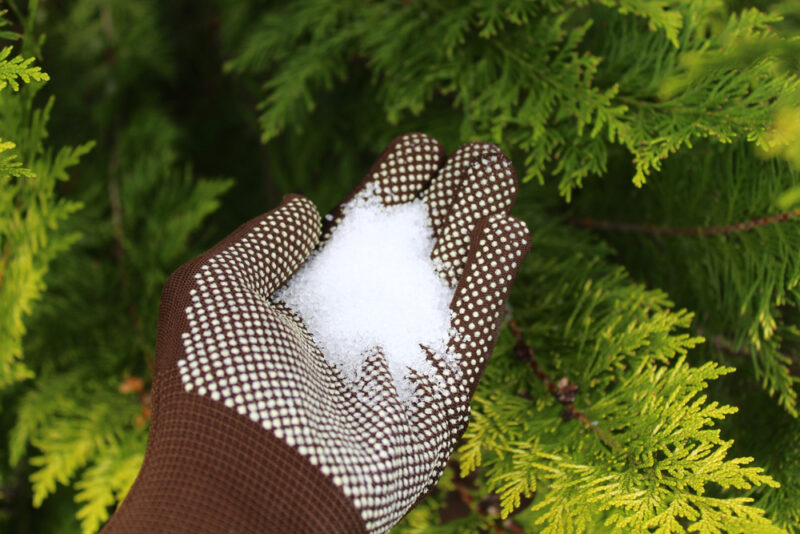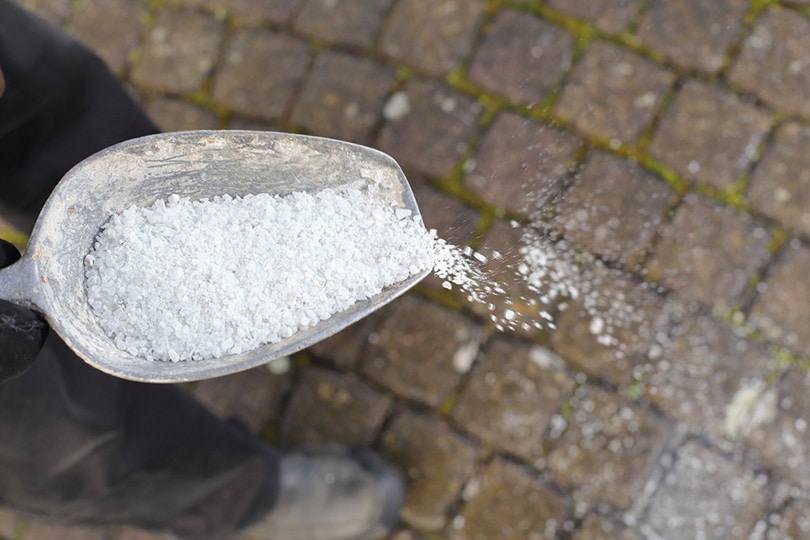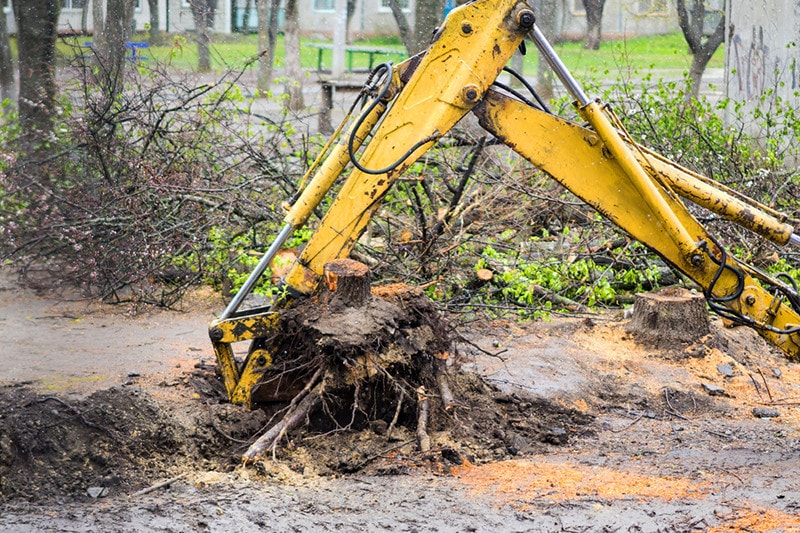How to Kill Tree Roots (3 Expert Tips)
-
Pete Ortiz
- Last updated:

Pulling out the chainsaw is often your only option when an aging tree is blocking your view, affecting the landscaping, or threatening your home’s safety. Killing the tree from top to bottom is crucial to prevent future problems, and there’s typically far more to it than simply cutting it down.
Anyone who has ever dealt with a weedy garden knows all about life’s often irritating resilience. Even cutting it off at the ankles and grinding away the stump isn’t always enough to keep a tree down forever. While roots are unlikely to continue growing, they’ll make every effort to draw nutrients to reshoot and survive, leaving you with brand-new headaches to handle.
Save time and effort by finishing the job the first time. After felling a tree, kill the tree roots to prevent future growth with one of these effective methods.
 The 3 Tips to Kill Tree Roots
The 3 Tips to Kill Tree Roots
1. Epsom Salt

| Tools and Materials | Drill, wide (1”+) drill bit, Epsom salt, water |
Epsom salt, consisting of magnesium and sulfur, can make a beneficial soil amendment and foliar spray for plants, but applying too much of a good thing will also kill off unwanted tree roots.
A stump and leftover roots can take 7+ years to decay completely, leaving the potential for regrowth after you cut the tree down. Epsom salt accelerates the process in large quantities, drying out the growth and inhibiting the roots’ ability to take up vital nutrients, including potassium, iron, and calcium.
You’ll see signs of decay within about 4–6 months, though larger tree stumps and root systems may take over a year to die. The stump will soften, split, and start shedding bark more easily. Though it isn’t the fastest way to take out old tree roots, Epsom salt offers one of the easiest, safest, and most inexpensive options for the average homeowner.
How to Kill Tree Roots with Epsom Salt
- Drill several holes into the stump’s cut top, making each one 3–4 inches deep and about an inch wide
- Fill the holes with Epsom salt
- Sprinkle in water to let the salt dissolve and absorb more readily into the trunk (avoid using too much water)
- Drill holes in exposed shallow roots to fill with Epsom salt and water
- Cover the stump and roots with plastic sheeting or a tarp to prevent wind and rain from washing the salt away from the stump
- Repeat every 2–3 weeks until the stump and tree roots are dead
2. Rock Salt

| Tools and Materials | Drill, wide (1”+) drill bit, rock salt, water |
Like Epsom salt, rock salt pulls moisture away from tree roots to starve them of nutrients. With the stump cut down as far as possible, drill several holes 3–4 inches deep and 1 inch wide at downward angles in the stump and the roots. Fill them with rock salt.
Instead of laying a tarp over the stump and roots, cover them in topsoil and a layer of mulch. Bacteria and fungi in the soil will speed the roots’ decay and attract other bugs that can break them down further. Water the mulch once every 2–3 days to dissolve the salt and feed the helpful fungi decomposing the tree.
Take care to prevent salt from contaminating nearby soil, as the heightened salinity can hinder future plant growth. But if you aren’t concerned about nearby vegetation, you can also spread a ring of salt around the tree stump to penetrate the soil and directly affect the roots.
3. Herbicide

| Tools and Materials | Chainsaw, herbicide, garden sprayer/paintbrush |
A concentrated herbicide with at least 41% glyphosate is one of the fastest methods for killing tree roots for easy removal. When used correctly, it can kill tree roots in about 2–4 weeks.
As a systemic herbicide, glyphosate moves through the tree’s phloem to kill the roots. Phloem, the short-lived inner bark that eventually becomes outer bark, is the transport system that feeds the root system with sugary photosynthesis products from the tree’s leaves. Applying glyphosate to a tree’s interior layers will facilitate that flow through the tree into the roots and hasten their breakdown.
 How to Kill Tree Roots with Herbicide
How to Kill Tree Roots with Herbicide
Trees reseal wounds quickly, starting within minutes of being cut and limiting a herbicide’s ability to penetrate down to the roots. Before treatment, cut a fresh slice off the stump, bringing it as low to the ground as possible (1–2 inches tall). Peel away the outer bark to reveal the cambium layer, the ring just past the phloem.
With fresh wood exposed, spray the top and sides of the tree using a 41% or higher-concentrated glyphosate formula with water in a 1:1 ratio in a garden sprayer. You can also use an undiluted 20% glyphosate formula.
Spray enough herbicide to cover the trunk top and sides, keeping it from splashing or pooling. Glyphosate has relatively low toxicity to humans, breaks down efficiently in soil, and is unlikely to harm plants from root uptake. But if it drifts, it could accumulate in young growth and enter root systems via plant leaves. To protect nearby plants, apply the herbicide with a paintbrush instead of a garden sprayer.

How Do You Kill Tree Roots in a Pipe?
Tree roots invading a sewer pipe need swift intervention. Small leaks may appear in lines, attracting nearby nutrient-thirsty roots that will often enter the opening. From there, solids entering the line can quickly create clogs. Even worse, the root will likely expand in the pipe, causing it to burst.
While you’ll eventually need to remove the root and repair the pipe to prevent ongoing leakage and soil erosion around the line, you can prevent a worsening situation by killing it first.
- Pour half a cup of copper sulfate down the toilet, flushing several times to drain the crystals into the sewer pipe
- Flush half a pound of rock salt down the toilet, and repeat about four times (flushing two pounds total)
- Run a foaming root killer in your toilet to kill current roots and prevent future growth
After applying your treatment, do not run the water in the house for 8–12 hours, as you may wash away the root killer. With proper use, these solutions can safely kill tree roots in sewer or septic systems.
Check local hardware stores, garden centers, and drug stores for an appropriate product. Follow the instructions carefully, repeating applications to kill and prevent roots. Foaming killers often only need an annual reapplication, but you will need to flush rock salt every 1–2 months for the best results.
Do Trees Grow Back After Being Cut Down?
Roots stop growing after you cut down a tree because there are no leaves to photosynthesize and promote root growth. In many cases, cutting down the tree and grinding out or burning the stump will prevent any chance of suckering and the tree developing more roots. Pines, oaks, maples, cedar, and fir trees are only a few of the many tree varieties that will typically start to die after you cut them down.
Fast-growing deciduous trees, by contrast, can grow more aggressively, making it critical to kill the roots.
- Poplar trees
- Tree of heaven
- Elm trees
- Ficus trees
- Olive trees
Check the stump regularly after cutting down a tree; remove any sprouts and apply a root-killing remedy as needed. Shallow root systems can also create suckers if they receive enough light. A poplar tree may produce a sucker dozens of feet away from the stump due to its sprawling roots, so understanding and monitoring the tree’s spread is crucial to avoid missing any emergent growth.
 Conclusion
Conclusion
Trees can be magnificent landscaping features, but root systems rarely do much more than create a threat to your property. They’ll lift sidewalks, damage foundations, blast through sewer pipes, and create an annoying backyard tripping hazard. And with their determination to survive, following these expert tips to kill a tree’s roots after cutting it down can save you a world of frustration in the long run.
See also:
Featured Image Credit: Axente Vlad, Shutterstock
Contents

 The 3 Tips to Kill Tree Roots
The 3 Tips to Kill Tree Roots How to Kill Tree Roots with Herbicide
How to Kill Tree Roots with Herbicide